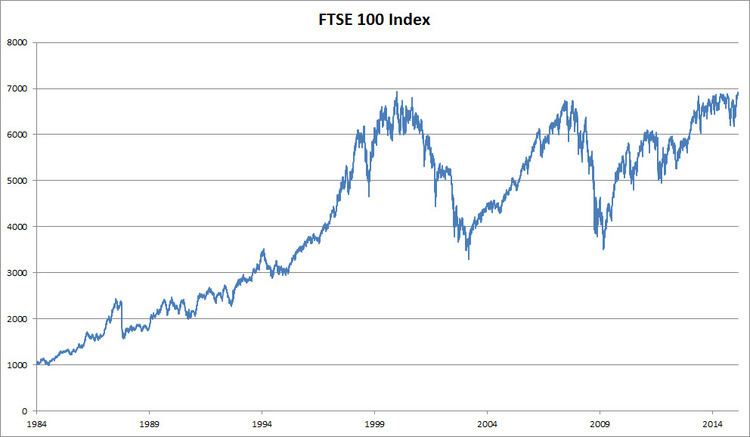Foundation 1984 Type Large cap | Operator FTSE Group Constituents 101 | |
 | ||
Market cap £1.7 trillion(as of Sept 2016) | ||
The Financial Times Stock Exchange 100 Index, also called the FTSE 100 Index, FTSE 100, FTSE, or, informally, the "Footsie" /ˈfʊtsi/, is a share index of the 100 companies listed on the London Stock Exchange with the highest market capitalization. It is seen as a gauge of prosperity for businesses regulated by UK company law. The index is maintained by the FTSE Group, a subsidiary of the London Stock Exchange Group.
Contents
- Overview
- Weighting
- Current constituents by market capitalisation as of February 2016
- List of constituents
- Past constituents
- FT 30
- References
The index began on 3 January 1984 at the base level of 1000. The highest value to date (7,383) was reached on 1 March 2017. The previous peaks were over 17 years previously, on the last trading day of 1999, during the dot-com bubble, and in April 2015, when the Index reached 7103.98. After falling during the financial crisis of 2007-2010 to below 3500 in March 2009, the index recovered to a peak of 6091.33 on 8 February 2011, then fell again to under the 5000 mark on the morning of 23 September 2011, but reached a record high on the afternoon of 1 March 2017.
Overview
The index is maintained by the FTSE Group, a now wholly owned subsidiary of the London Stock Exchange which originated as a joint venture between the Financial Times and the London Stock Exchange. It is calculated in real time and published every second when the market is open.
The FTSE 100 broadly consists of the largest 100 qualifying UK companies by full market value. Many of these are international companies, however, so the index's movements are a fairly weak indicator of how the UK economy is faring. A better indication of the UK economy is the FTSE 250, as it contains a smaller proportion of international companies. The constituents of the FTSE are determined quarterly, on the Wednesday after the first Friday of the month in March, June, September and December. The values used to make the changes to the indices are taken at the close of business the night before the review.
FTSE 100 companies represent about 81% of the entire market capitalisation of the London Stock Exchange. Even though the FTSE All-Share Index is more comprehensive, the FTSE 100 is by far the most widely used UK stock market indicator. Other related indices are the FTSE 250 Index (which includes the next largest 250 companies after the FTSE 100), the FTSE 350 Index (which is the aggregation of the FTSE 100 and 250), FTSE SmallCap Index and the FTSE Fledgling Index. The FTSE All-Share aggregates the FTSE 100, FTSE 250 and FTSE SmallCap.
Component companies must meet a number of requirements set out by the FTSE Group, including having a full listing on the London Stock Exchange with a Sterling or Euro denominated price on the Stock Exchange Electronic Trading Service, and meeting certain tests on nationality, free float, and liquidity.
The constituent companies were criticised for their lack of diversity at the boardroom level in a 2014 study which found that more than half of them had no non-white board members, and two thirds did not have any executive directors from minorities.
Continuous trading on the London Stock Exchange starts at 08:00 and ends at 16:30 (when the closing auction starts), and closing values are taken at 16:35.
Weighting
In the FTSE indices, share prices are weighted by market capitalisation, so that the larger companies make more of a difference to the index than smaller companies. The basic formula for these indices is:
The Free float Adjustment factor represents the percentage of all issued shares that are readily available for trading. The factor is then rounded up to the nearest multiple of 5%. To find the free-float capitalisation of a company, first find its market cap (number of shares x share price) then multiply by its free-float factor. Free-float capitalisation, therefore, does not include restricted stocks, such as those held by company insiders.
Current constituents by market capitalisation as of February 2016
The following table lists the FTSE 100 companies measured by market capitalisation after the changes on 15 February 2016. The numbers of employees are taken from company reports, mostly dated between 2013 and 2015, and the Financial Times. The index consists of 100 companies, but there are 101 listings, as Royal Dutch Shell has both A and B class shares listed. Schroders Non Voting shares were also listed until 1 June 2012 when the FTSE's stricter rules came into force.
List of constituents
The constituents following the changes of 19 December 2016 were as follows:
Past constituents
source: "FTSE: FTSE 100 Constituent Changes" (PDF). (57.9 KB)
FT 30
The oldest continuous index in the UK is the FT 30, also known as the Financial Times Index or the FT Ordinary Index (FTOI). It was established in 1935 and nowadays is largely obsolete due to its redundancy. It is similar to the Dow Jones Industrial Average, and companies listed are from the industrial and commercial sectors. Financial sector companies and government stocks are excluded.
Of the original constituents, four are currently in the FTSE 100: Guest Keen & Nettlefolds (GKN), Tate & Lyle, Imperial Tobacco and Rolls-Royce, although Rolls-Royce has not been continuously listed and Imperial Tobacco was a subsidiary of Hanson for a number of years. ICI was removed when it was taken over by Akzo Nobel in January 2008. Two of the original FT 30 companies are still in that index: GKN and Tate & Lyle (membership is not strictly based on market capitalisation, so this does not mean they are necessarily among the top thirty companies in the FTSE 100). The best performer from the original lineup has been Imperial Tobacco.
